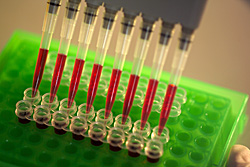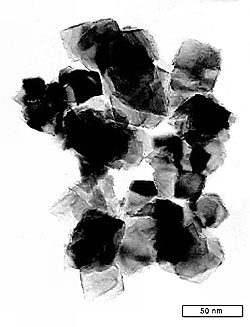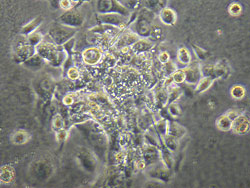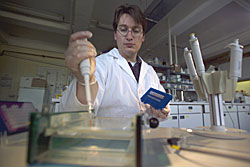Press release April 11th, 2006
Nanoparticles put to the test
New research consortium examines possible risks with the goal of supporting small and medium-sized companies.
Dresden/Leipzig. A new research project is investigating the effects of nanoparticles at the research and development stage on people’s health and the environment. These particles, which are less than 100 nanometres in size, are being developed, among other applications, for surface finishing, for catalysts and fuel cells or for use in the electrical industry.

Using multi-pipettes for nanoparticle research
Foto: André Künzelmann/UFZ

The picture of the nanoparticles was taken by transmission electron microscope
Foto: Dr. Volkmar Richter, Dresden Fraunhofer Institute for Ceramic Technologies and Systems (IKTS)

The effects of nanoparticles are being tested on human cell cultures
Foto: Dr. Kristin Schirmer/UFZ

Dr. Christoph Veß, UFZ (Department of Cell Toxicology) in his research lab
Foto: André Künzelmann/UFZ
The INOS research project (Identification and Assessment of the Effects of Engineered Nanoparticles on Human and Environmental Health) is planned for three
years and has received financial support of over one million euro from the German Ministry of Research. The aim is to create a scientifically-based data base
where anyone can find information about the potential risks of nanoparticles.
Experience with other emerging technologies has shown that they are only accepted by society if possible health effects are analysed and published early on.
Nanotechnologies are considered the growth market of the future. The Federal Ministry of Research expects the world market for products influenced by
nanotechnologies to increase ten-fold in the next few years, to a total of one trillion euro. However, small and mid-sized companies in particular are often not
capable of testing the risks of nanoparticles to any great extent or over a long time by their own means. This is why a certified laboratory shall be
established following the research project; one which will mainly act as a contact partner to mid-sized firms, coordinating and carrying out analyses of the
possible risks of nanoparticles.
Research institutes and companies from Dresden and Leipzig involved in material sciences, environmental sciences and medicine have therefore come together to form a research consortium. Taking part are the Max Bergmann Centre for Biomaterials (MBZ), the “Carl Gustav Carus” medical faculty of Dresden University of Technology, the Fraunhofer Institute for Ceramic Technologies and Systems (IKTS) and Namos GmbH from Dresden, as well as the Leipzig-Halle Centre for Environmental Research (UFZ).
One thousandth the diameter of a human hair – that is how small they are, these synthetically-produced nanoparticles we are hearing more and more about in many branches of industry, and also in the public domain. What are synthetic nanoparticles and what makes them so attractive? The word “nano” comes from Greek and means “dwarf”. Typically, particles below 100 nanometres in size (one billionth of a metre) are termed nanoparticles. This is the range in which materials can sometimes take on entirely new characteristics because of their small size. For example, carbon nanotubes have a greater tensile strength than steel, are very good electrical conductors and conduct heat better than diamonds, until now the best-known heat conductors. Products made of nanoparticles can, for example, absorb considerably more light or be used as far more effective catalysts, as they have a larger surface with the same mass compared with larger particles. This is why improved or entirely new solutions are expected from nanotechnology in information technology, medicine, environmental technology, cosmetics and materials. Yet how do things stand with nanoparticles’ compatibility with human beings and the environment? What happens if particles which are a thousand times smaller than human cells come into contact with these cells?
These are the questions the INOS research consortium is dedicated to answering. Within this project, scientists are examining whether and under what conditions nanoparticles, which could in future be of importance for engineering, the chemicals industry, energy management and microelectronics, can produce undesired effects on the cells of human beings and fish. The testing will first be carried out in vitro, i.e. outside the organisms, using different cell cultures, and the results will then be made available to the public in a freely accessible data base. Methods are being developed which will allow a large number of particles to be examined under predefined conditions for their effects on cells, with no animal testing, giving prior indication of any potential dangers. What the researchers are particularly interested in here is whether the function and viability of cells of the nervous system, lungs, intestines or the skin are influenced and if genetic damage or changes in immunoregulation are possible.
Further links on the theme of nano technologies:
Here is the research project’s databank in future online:
www.nanotox.de
Federal Ministry for Education and Research brochure “Wunderwelt Werkstoffe”:
Werkstoffwelten
More specialised information:
Projektkoordinator:
Prof. Wolfgang Pompe
Max-Bergmann-Zentrum für Biomaterialien (MBZ)
phone: +49 (0) 351- 463-31420
www.mpgfk.tu-dresden.de/index.html
Sub-project manager::
Dr. Kristin Schirmer
Helmholtz Centre for Environmental Research – UFZ
phone: +49 (0) 341-235-2699
www.ufz.de/index.php?de=5330
or
Doris Böhme / Tilo Arnhold,
Public Relations of Helmholtz Centre for Environmental Research – UFZ
phone: +49-341-235-2278
e-mail: presse@ufz.de
Prof. Hrissanthi Ikonomidou
Neuropediatrics Department
TDresden University of Technology
phone: +49 (0) 351-4582230
www.tu-dresden.de/kin
Dr. Volkmar Richter
Fraunhofer Institute for Ceramic Technologies and Systems
phone: +49 (0) 351-2553-614
www.ikts.fraunhofer.de
Dr. Jürgen Hofinger
Namos GmbH
phone: +49 (0) 351-796 572-0
www.namos.de
